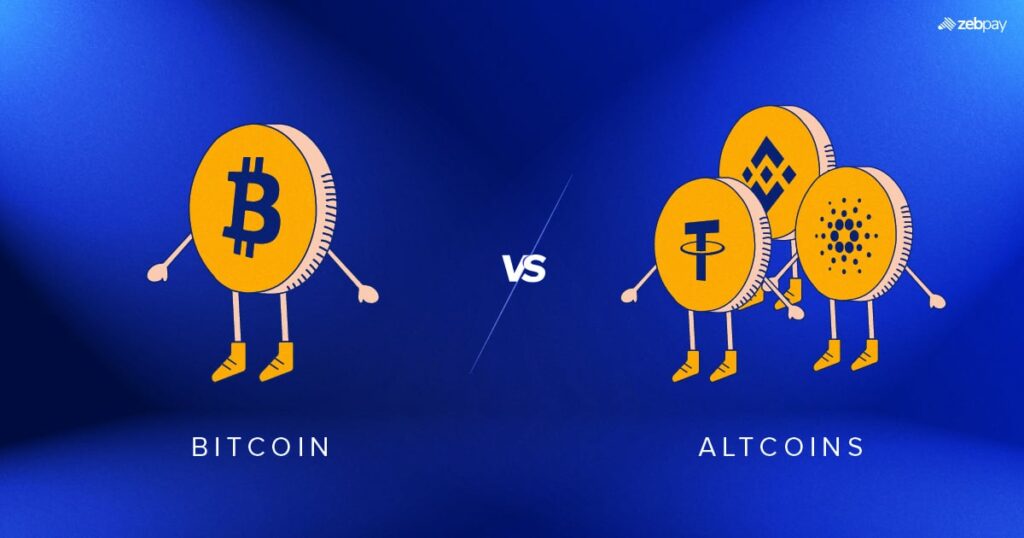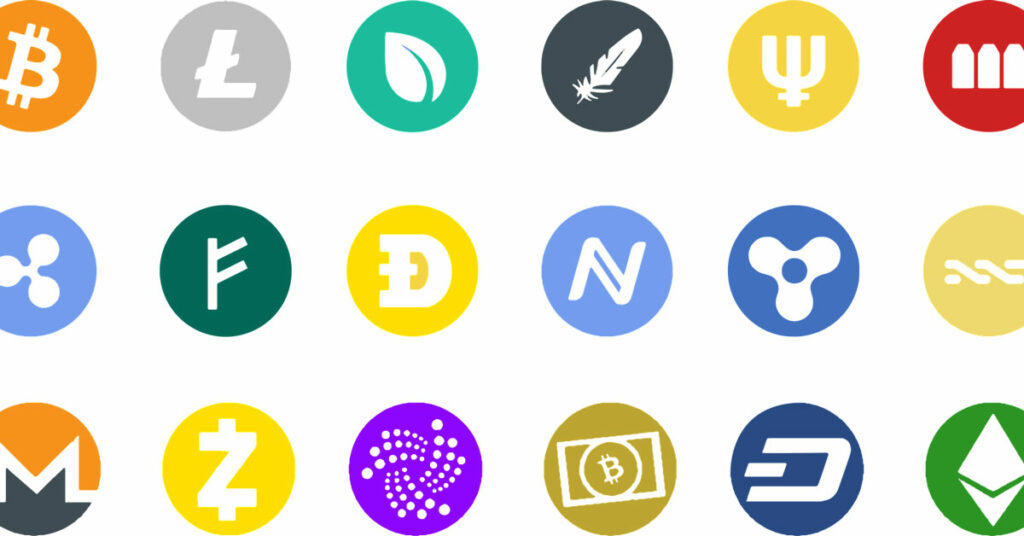In the dynamic universe of cryptocurrencies, Bitcoin reigns as the trailblazer, the inaugural digital currency that revolutionized finance. Alongside Bitcoin, a myriad of alternative cryptocurrencies, known as altcoins, have emerged, each offering unique features, purposes, and visions. Understanding the differences between Bitcoin and altcoins goes beyond the surface of their monetary values; it delves into the underlying technology, market dynamics, adoption, and potential impact on the future of finance. This exploration unveils not just a juxtaposition of values but a reflection of the diverse spectrum of innovation, possibilities, and complexities within the cryptocurrency ecosystem.
Bitcoin, conceived in the aftermath of the 2008 financial crisis, introduced the world to blockchain technology and decentralized digital currency. As the pioneer, Bitcoin boasts a robust and secure network, serving as a store of value and a digital gold standard in the cryptocurrency space. Its limited supply and scarcity, with a capped maximum supply of 21 million coins, underpin its value proposition, positioning it as a trusted asset for investors seeking stability amidst market fluctuations. Conversely, altcoins encompass a diverse array of cryptocurrencies beyond Bitcoin, each striving to carve its niche by offering innovative solutions, faster transaction speeds, enhanced privacy features, or unique consensus mechanisms. These alternative coins foster experimentation and evolution within the digital currency landscape, pushing the boundaries of blockchain technology and challenging Bitcoin’s dominance.

Exploring the nuanced differences between Bitcoin and altcoins unveils a dynamic ecosystem where technological innovation meets diverse ideologies. While Bitcoin stands as a bedrock, revered for its stability and long-standing history, altcoins spark innovation, addressing specific use cases, and vying for broader adoption. Beyond mere investment opportunities, this comparison paints a tapestry of technological evolution, ideological diversity, and the relentless pursuit of reshaping the future of finance through cryptocurrencies.
Understanding Bitcoin
Bitcoin, introduced by an anonymous entity under the pseudonym Satoshi Nakamoto in 2008, represents the genesis of decentralized digital currency. Its inception aimed to create a peer-to-peer electronic cash system, bypassing intermediaries like banks and enabling direct transactions between users. The history of Bitcoin is entrenched in the release of its whitepaper, outlining the underlying technology of blockchain and the mining of its first block, known as the “genesis block,” in 2009. This marked the commencement of the Bitcoin network and the birth of a new era in financial technology, catalyzing a global movement towards decentralized digital currencies.
Characterized by decentralization, scarcity, and transparency, Bitcoin stands distinct in the cryptocurrency landscape. Its decentralized nature eliminates the need for a central authority, relying on a distributed network of nodes to validate and record transactions on the blockchain. The issuance of Bitcoin is governed by a pre-defined algorithm that gradually releases coins through a process called mining, ensuring a capped maximum supply of 21 million coins. This scarcity drives its value proposition as a store of value akin to digital gold. Bitcoin’s impact extends beyond its monetary value; it serves as a catalyst, inspiring the development of numerous altcoins and blockchain projects. Its role as the pioneering cryptocurrency establishes a benchmark for trust, security, and legitimacy within the broader cryptocurrency ecosystem.
Exploring Altcoins
Altcoins, a collective term for cryptocurrencies other than Bitcoin, encompass a diverse array of digital assets offering distinctive features and functionalities. Differentiating themselves from Bitcoin, altcoins leverage various technological innovations and philosophies to address specific shortcomings or introduce novel concepts in the cryptocurrency space. These alternative coins are often characterized by variations in consensus mechanisms, privacy features, transaction speeds, and use cases. Some notable types of altcoins include privacy coins like Monero (XMR), aiming to enhance anonymity in transactions, or smart contract platforms like Ethereum (ETH), designed to enable decentralized applications and programmable contracts.

Notable altcoins encompass a spectrum of cryptocurrencies with unique value propositions and use cases. Ethereum, among the most prominent altcoins, introduced the concept of smart contracts, facilitating the development of decentralized applications (dApps) and the issuance of tokens. Ripple (XRP), another noteworthy altcoin, focuses on enabling faster and more cost-effective cross-border transactions for financial institutions. Litecoin (LTC) is recognized for its faster block generation times and scalability improvements compared to Bitcoin. Each altcoin introduces distinct features, addressing specific market demands and exploring innovative applications of blockchain technology beyond financial transactions. These diverse offerings within the altcoin space showcase the dynamism and versatility present in the broader cryptocurrency ecosystem.
Comparative Analysis: Bitcoin vs. Altcoins
Distinguishing factors between Bitcoin and altcoins extend to their underlying technology and infrastructure. While Bitcoin remains anchored in its proof-of-work (PoW) consensus mechanism, most altcoins explore diverse consensus models like proof-of-stake (PoS), delegated proof-of-stake (DPoS), or proof-of-authority (PoA). These alternative consensus mechanisms offer variations in terms of energy efficiency, transaction speed, and decentralization. Additionally, altcoins often experiment with different cryptographic algorithms or governance structures, aiming to address Bitcoin’s limitations or cater to specific use cases.
Market dynamics and price movements reflect contrasting behavior between Bitcoin and altcoins. Historically, Bitcoin has displayed relatively lower volatility compared to many altcoins, often serving as a benchmark for the entire cryptocurrency market. Altcoins, on the other hand, tend to experience more significant price swings due to their smaller market capitalization, lower liquidity, and susceptibility to market sentiment. While Bitcoin’s dominance is evident, altcoins may showcase rapid price fluctuations, sometimes outperforming Bitcoin in short periods but also posing higher risks due to their volatility.
Investment Considerations
The investment potential of Bitcoin lies in its status as a digital store of value, often likened to gold in the digital realm. Investors consider Bitcoin as a hedge against inflation and market uncertainties, seeking its perceived stability amid economic fluctuations. Contrastingly, altcoins present growth potential driven by their innovative features and applications. The allure of investing in altcoins revolves around the opportunity to capitalize on significant price movements and technological advancements, potentially offering higher returns compared to Bitcoin.

Risk and volatility profiles differ between Bitcoin and various altcoins. Bitcoin, established as a relatively stable cryptocurrency, exhibits lower volatility compared to many altcoins, making it a more conservative investment option. Altcoins, with their smaller market capitalization and susceptibility to market sentiment, often experience higher volatility, presenting both opportunities for substantial gains and increased risks of significant losses. Factors influencing investment decisions encompass a myriad of considerations, including technological advancements, regulatory developments, market sentiment, and the specific use case or utility of a cryptocurrency. Evaluating these factors aids investors in making informed decisions and building diversified portfolios tailored to their risk tolerance and investment objectives.
Regulation and Mainstream Acceptance
The regulatory landscape significantly influences both Bitcoin and altcoins, shaping their market dynamics and potential adoption. Bitcoin, being the pioneering cryptocurrency, often bears the brunt of regulatory scrutiny due to its prominence in the market. Regulatory outlooks worldwide vary, with some countries embracing Bitcoin as a legitimate asset class or payment method, while others impose strict regulations or bans. Altcoins face similar regulatory challenges, with authorities often assessing them based on their utility, security features, and compliance with existing financial regulations. Regulatory clarity remains pivotal for the wider acceptance and stability of both Bitcoin and altcoins within the global financial ecosystem.
In terms of mainstream adoption and real-world applications, Bitcoin and altcoins portray distinct use cases and levels of acceptance. Bitcoin’s primary use case as a store of value and digital gold has gained recognition among institutional investors and corporations as a hedge against inflation. Meanwhile, altcoins explore diverse applications beyond finance, including decentralized finance (DeFi), supply chain management, gaming, and identity verification. Some altcoins, like Ethereum, have paved the way for smart contracts and decentralized applications, revolutionizing various industries. While Bitcoin holds dominance as a digital asset, altcoins’ versatility and innovation position them as catalysts for disruptive technological advancements in specific niches.
Conclusion
The comparison between Bitcoin and altcoins encapsulates a dynamic narrative within the evolving cryptocurrency realm. Bitcoin, as the trailblazer, solidifies its position as a digital store of value, fostering trust among investors and institutions seeking stability in a volatile financial landscape. Its impact reverberates beyond its monetary value, serving as the bedrock of decentralization and inspiring a myriad of alternative cryptocurrencies, each vying to carve its niche and disrupt traditional sectors. Altcoins, with their innovative features and varied applications, herald a new wave of technological advancements, exploring realms beyond finance and challenging the boundaries of blockchain technology.

Navigating the future terrain for both Bitcoin and altcoins entails grappling with regulatory intricacies, striving for mainstream acceptance, and addressing pressing challenges. Regulatory outlooks globally will shape the trajectory of cryptocurrencies, dictating their legitimacy, market accessibility, and potential growth. While Bitcoin asserts itself as a stalwart in the digital asset landscape, altcoins continue to push boundaries, seeking adoption and recognition for their unique use cases. Overcoming scalability hurdles, navigating regulatory landscapes, and harnessing mainstream acceptance will be pivotal for the enduring success and relevance of both Bitcoin and altcoins in shaping the future of finance and technology.
As investors, enthusiasts, and innovators traverse this complex landscape, the synergistic interplay between Bitcoin and altcoins underscores a transformative journey. Their evolution represents not just a shift in financial paradigms but a testament to the relentless pursuit of technological innovation and decentralized solutions. As the story unfolds, Bitcoin’s established presence harmonizes with altcoins’ ingenuity, creating a vibrant ecosystem where innovation, adoption, and regulation converge to define the next chapter in the profound narrative of cryptocurrencies.





Add comment